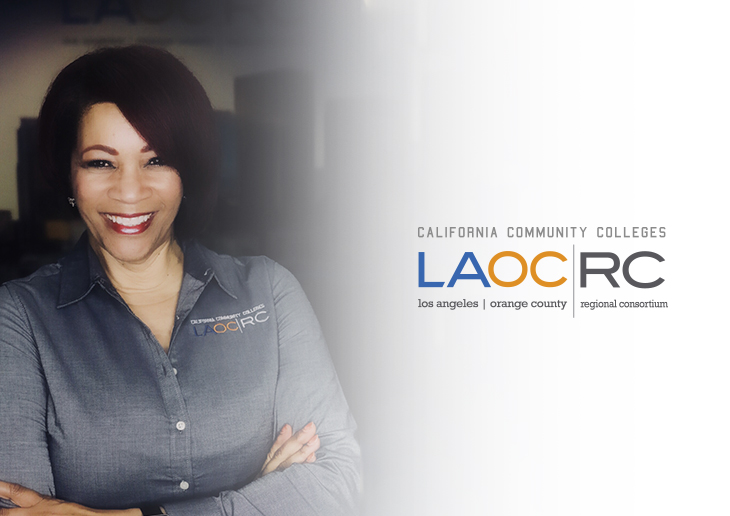Report Shows LA and OC Community Colleges Are Building a Strong Workforce Feature Story
January 28, 2020

In 2018, California surpassed the United Kingdom to become the world’s fifth largest economy. But despite having a gross domestic product of nearly $3 trillion, California, like the rest of the country, faces a middle-skills job gap that is threatening to derail its current economy and future prosperity.
In 2016, the California Legislature allocated $200 million of the state’s budget to a workforce training program that was intended to address this job gap which experts predict will leave more than 1 million jobs unfilled in California by 2025. The Los Angeles Orange County Regional Consortium (LAOCRC) was one of seven regional consortia funded to enhance career technical education and workforce training to meet the demands of regional economies and the state’s labor market.
This month, the LAOCRC released a comprehensive report chronicling these efforts. Titled Strong Workforce Program Regional Projects Report, Year 1: Building a Strong Workforce and Promoting Prosperity, the report is a compilation of fiscal and narrative accounts of 37 projects in Los Angeles and Orange Counties. The projects spanned 28 community colleges and one stand-alone continuing education center for a total of $22.7 million in Strong Workforce Program (SWP) state funding.
To download the full report, click here.
“This report demonstrates clearly the value that community colleges in the Los Angeles-Orange County region bring to workforce development,” says Dr. John Weispfenning, chancellor of Coast Community College District and a member of the LAOCRC CEO Executive Committee and Governance Council. “It’s the product of unprecedented collaboration between the colleges, employers, and the state. Across the board, we’re working to see that California’s needs are being met.”
As a whole, the report offers insight into how the LAOCRC region, during its first 30 months of Strong Workforce funding, worked collaboratively to leverage resources, information, and dollars to advance career education and meet the needs of new and everchanging industries. The report outlines the major activities of each project, the colleges involved, how goals were accomplished, and outcomes.
According to LAOCRC Executive Director Dr. Adriene “Alex” Davis, the success of these initial projects has sounded an encouraging tone for the future of career education in the state. “Career education is integral to the upward social and economic mobility of California residents who seek access to higher education,” says Davis. “The LAOCRC, in partnership with the state, is helping to lay the foundation for ongoing prosperity and equality for all.”
To read Davis’ introduction to the report, click here.
Strong Workforce investments in the region impact students who need access to education and career skills most. LAOCRC member colleges serve one-third of the disadvantaged students across all programs in the State of California, as well as one-third of the under-resourced students in career education.
Coinciding with the report’s distribution, LAOCRC is launching a marketing and outreach campaign to highlight the region’s efforts in advancing career education and access to higher education for all. This effort includes a one-page overview for distribution at the Capitol’s Legislative Day, social media posts, and advertisements in the following airports: LAX, John Wayne, Burbank and Long Beach. The common theme across the advertisements is “29 Strong” to acknowledge the 28 community colleges and one stand-alone continuing education center involved in the regional SWP projects.
“The breadth and depth of the SWP projects in our region are unprecedented,” said Davis. “It is important to let the state leadership and the CCC system know about our successes and the huge difference SWP investments are making in the region.”
Below are a few notable examples from the report that demonstrate the innovation, collaboration, and overall progress regional community colleges are making towards advancing career education, increasing student engagement, and bridging the skills gap in Orange County.
Preparing Students to Work in a Rapidly Changing Automotive Industry
The Automotive Collaborative Project brought together Cypress, Fullerton, Golden West, Saddleback, and Santa Ana Colleges—each with automotive programs in different phases of development—for the purpose of broadening and enhancing career exploration and planning, strengthening work-based learning opportunities, and improving career technical education (CTE) student progress and outcomes.
The collaboration made it possible for each college to receive professional development in advanced automotive technologies that could be integrated into new and existing courses, while also helping create a fundamental curriculum. Faculty received education and training in electric/hybrid technologies, alternative fuels, tires and brakes, and advanced transportation.
In addition, many received third-party certification from the Tire Industry Association. Funds were used to upgrade classroom equipment and purchase a Switch Lab—an education system consisting of an electronic vehicle kit that students can use to build an electric car over the course of a semester.
In an effort to strengthen relationships with the automotive industry in the region, automotive faculty and staff organized successful community outreach events that brought employers looking for interns and apprentices to their campus. With Saddleback College at the head, project leaders recruited employers willing to offer cooperative work experience through the colleges’ academic programs.
“We figured out a long time ago that we are stronger when we work together,” says Saddleback College Dean of Advanced Technology and Applied Science Anthony Teng. “By sharing resources and information we strengthen our programs, better serve our students and successfully feed employees into the region’s auto industry.”
Building a Biotech Path from K-12 to Community College and Career
Biotech is one of the fastest growing industries in the state, presenting students with many secure and well-paying career opportunities. But regionally, the number of students pursuing biotech careers is not keeping pace with demand. In response, the Regional Biotechnology Education Partnership—which includes Fullerton, Irvine Valley, Santa Ana, and Santiago Canyon Colleges—undertook efforts to expand student knowledge of related industries and occupations while more clearly defining K-to-college educational pathways.
The regional partnership started by creating a biotech program outline for K-12, transfer, CTE students, administrators and parents to raise awareness about the career opportunities that exist in biotechnology and related disciplines.
“Many students don’t really know what biotechnology is, especially high school students,” said Denise Foley, assistant biology professor at Santiago Canyon College. “Our partners are working to change that by building a pathway that students can follow all the way through the process of getting a job.”
One hallmark of this collaboration is that it developed organically, driven in large part by faculty across the participating colleges who come together routinely to develop classes and then go back to their respective institutions to obtain approvals and work on implementation.
“There’s tremendous buy-in and collaboration in the partnership, which has been key to the progress we have made so far,” said Elizabeth Arteaga, associate dean of business and career technical education at Santiago Canyon College.
On the employer front, partners held regular meetings to communicate with regional biotech stakeholders in order to assess their needs and match students with internship opportunities. The program also collaborated with industry partners to determine necessary skills and work-based learning experiences needed by students to help them succeed in their internships and jobs. And to help facilitate all this, Biotech/Advanced Manufacturing Regional Director Dr. Marlene Swider was hired to work more closely with education and business partners and to increase internship opportunities and job placement.
For more information about the partnership, biotechnology, and careers and internships in Orange County, visit OCbiotecheducation.org.
Raising Awareness of CTE Programs in Orange County
To help spread the word about the efficacy of career education and the proven benefits it can provide to individuals and corporations, the Los Angeles Orange County Regional Consortium (LAOCRC) hired Interact Communications, a full-service marketing company that works only with community colleges and their foundations, to develop a comprehensive marketing campaign.
Interact’s efforts began with in-depth research of Orange County’s community colleges (and regional perceptions of them) in order to inform planning, collateral development, and subsequent print, digital, and TV advertising, as well as email campaigns, newsletters, and social media. The result was the award-winning “Future BUILT” career education brand and marketing campaign.
To date, the campaign has driven more than 135,000 visits to the FutureBuilt.org website, collected over 180,000 unique page views, and generated more than 800 phone calls to Orange County community colleges all while smashing industry standards for pay-per-click rates on social media. Overall estimates across indoor, outdoor, and digital advertising suggest more than 78 million impressions.
More importantly, while the improving economy has meant that community college enrollment numbers have been decreasing statewide, enrollment numbers for many of Orange County’s community colleges have stayed steady and even increased.
“The Future BUILT campaign has played an important role in the success of the Orange County Community Colleges Workforce Initiative,” says Dr. Gustavo Chamorro, Orange County director of the LAOCRC and a key figure in bringing Interact on board. “Effective marketing can increase awareness of career education programs and support efforts to strengthen enrollment at our local community colleges.”
In addition to the excerpts mentioned here, the full report contains overviews and outcomes for over 30 more projects covering a full spectrum of the kinds of pioneering career education initiatives and partnerships that are putting Los Angeles and Orange County’s community colleges at the forefront of educational innovation and workforce development.
For more information about the report or the LAOCRC, visit www.LAOCRC.org.




